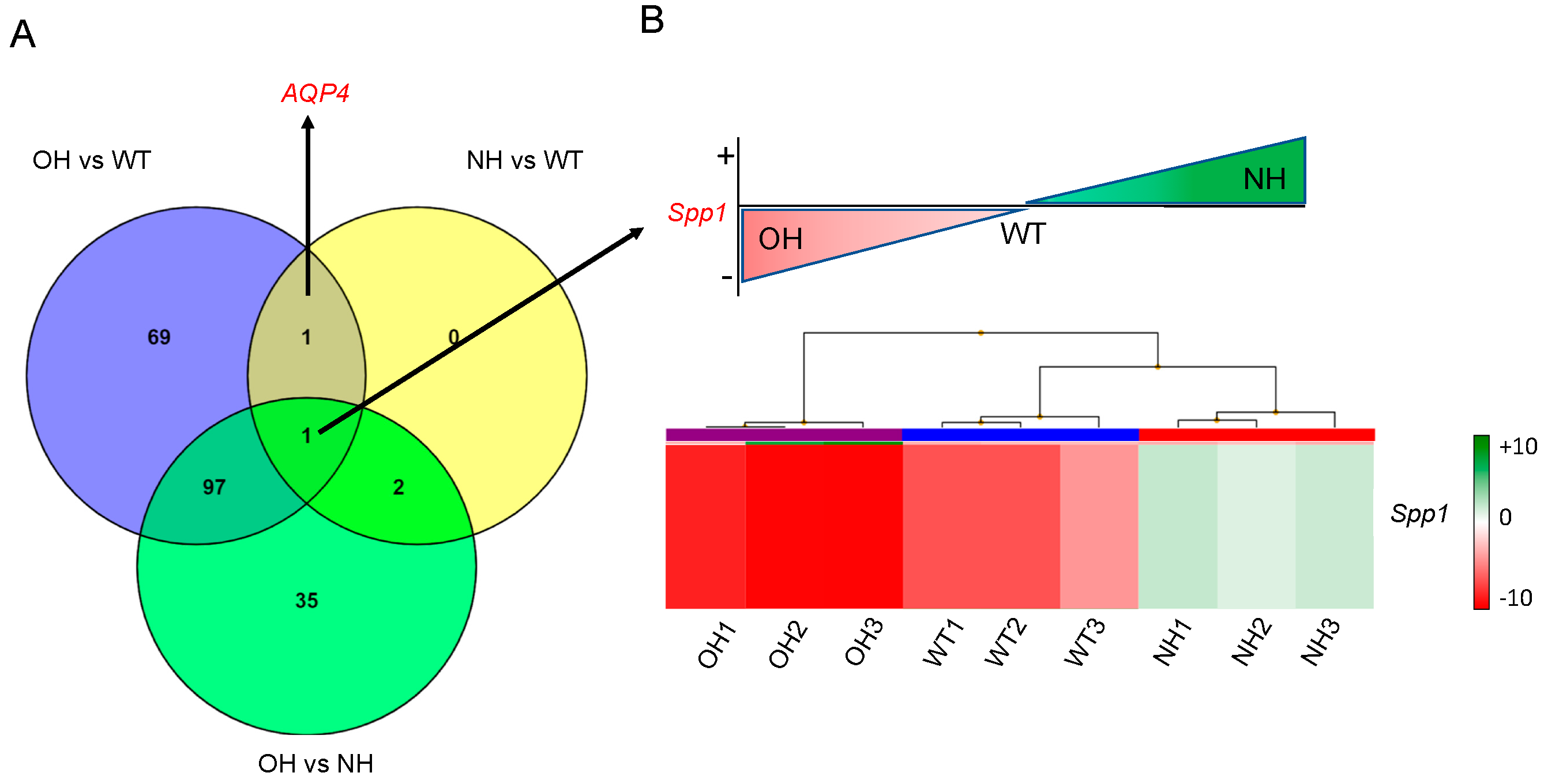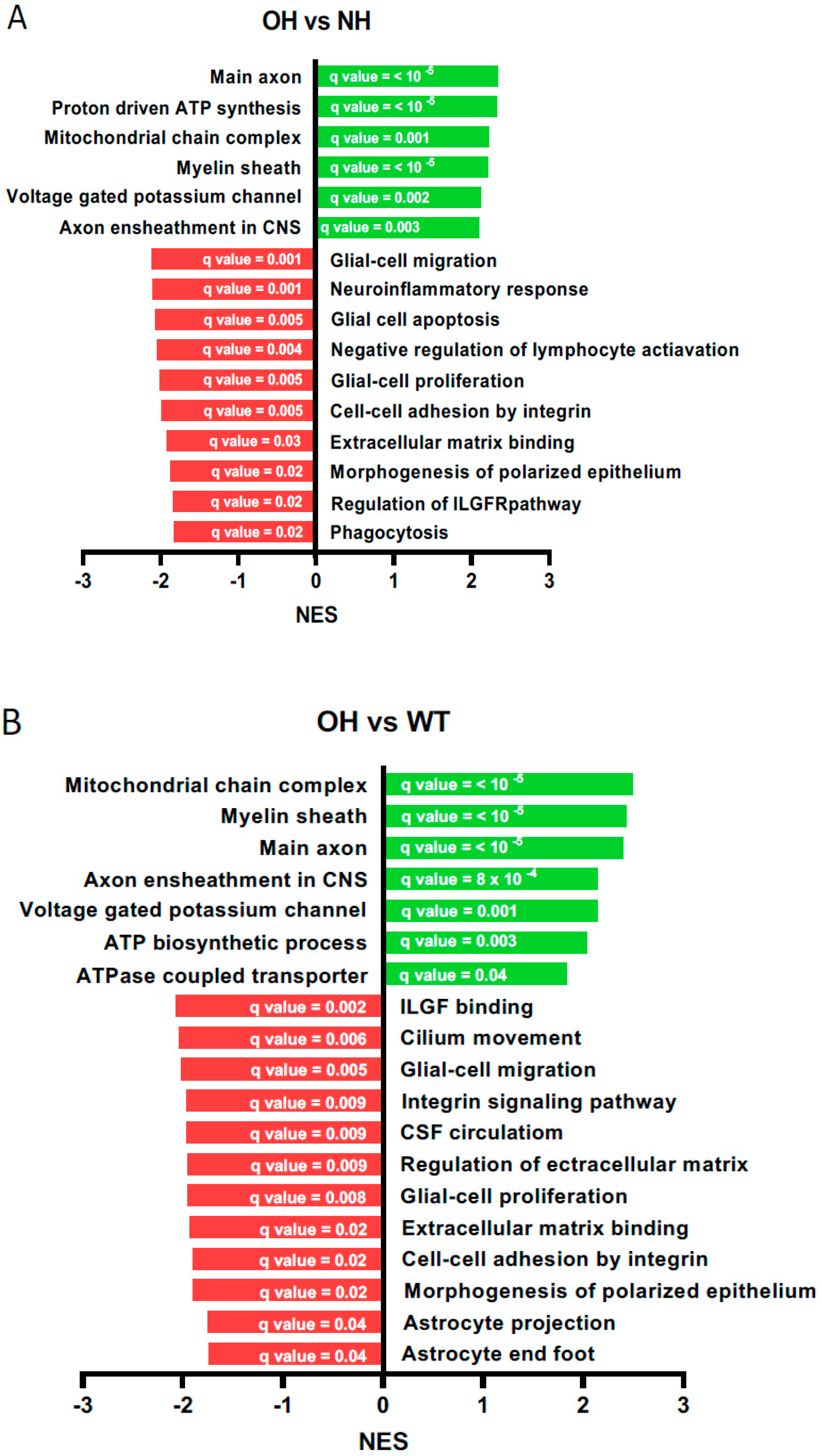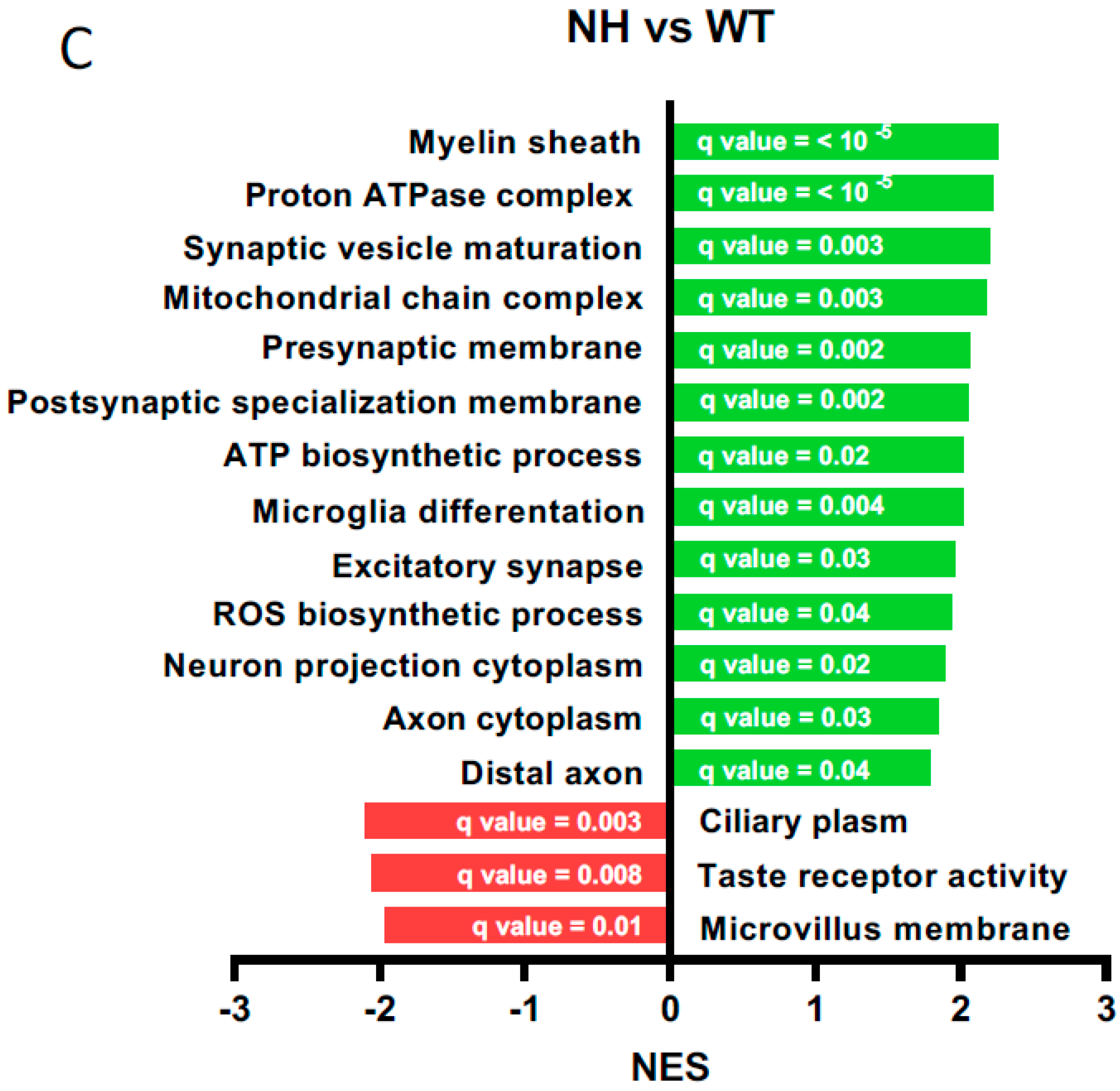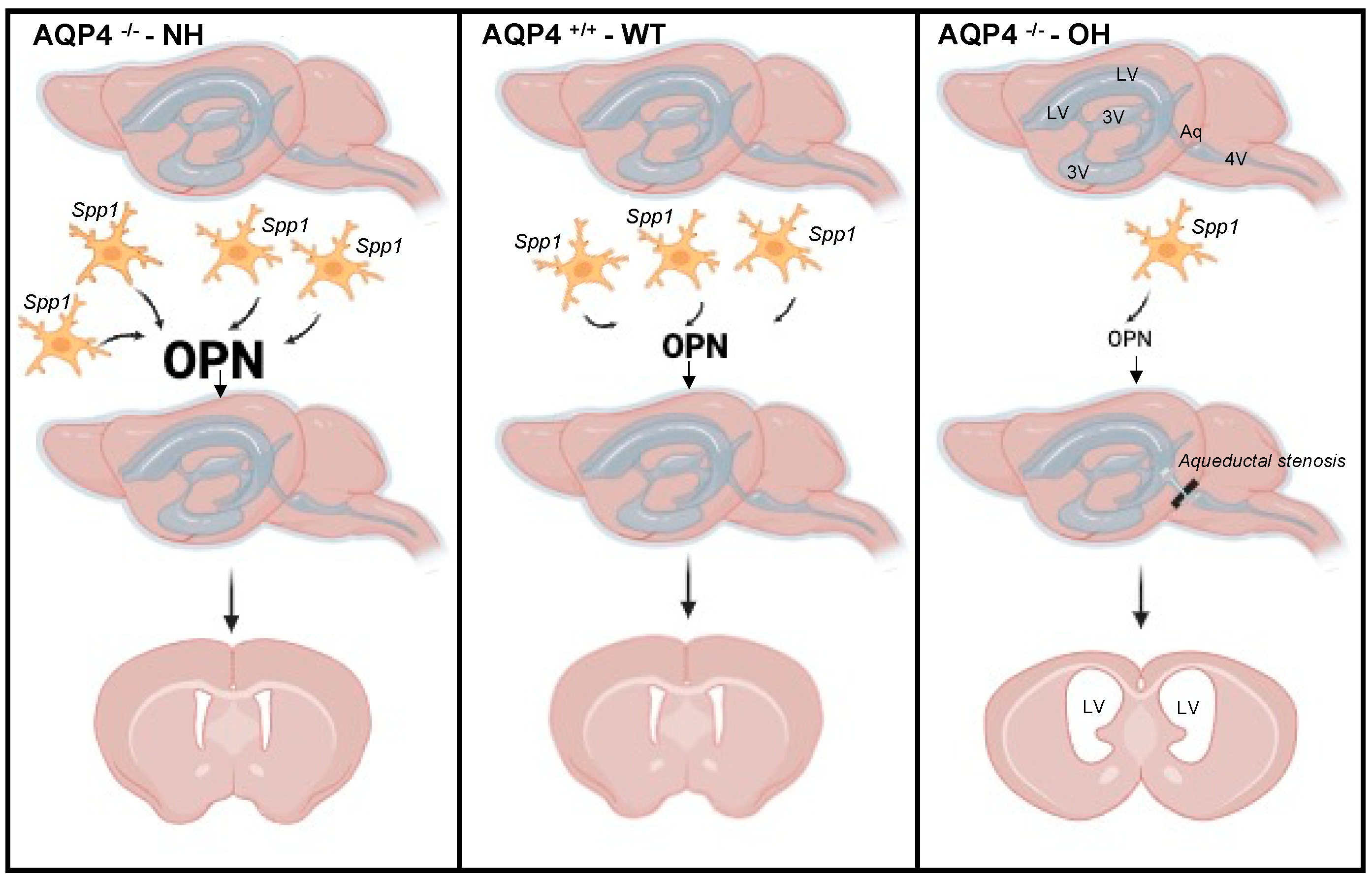Spp1 Appears to Be a Key Gene for Sporadic Obstructive Hydrocephalus in the Absence of AQP4
Abstract
1. Introduction
2. Results
2.1. Development of Obstructive Hydrocephalus in AQP4−/−-CD1 Mice
2.2. Microarray-Based Differential Gene Expression Study
2.3. Gene Set Enrichment Analysis
3. Discussion
4. Materials and Methods
4.1. Animals
4.2. RNA Purification
4.3. Differential Gene Expression by Microarray
4.4. Statistical Analysis
5. Conclusions
Supplementary Materials
Author Contributions
Funding
Institutional Review Board Statement
Informed Consent Statement
Data Availability Statement
Acknowledgments
Conflicts of Interest
References
- Del Bigio, M.R. History of Research Concerning the Ependyma: A View from inside the Human Brain. Front. Cell. Neurosci. 2024, 17, 1320369. [Google Scholar] [CrossRef]
- Johanson, C.E.; Duncan, J.A.; Klinge, P.M.; Brinker, T.; Stopa, E.G.; Silverberg, G.D. Multiplicity of Cerebrospinal Fluid Functions: New Challenges in Health and Disease. Cerebrospinal Fluid. Res. 2008, 5, 10. [Google Scholar] [CrossRef] [PubMed]
- Tumani, H.; Huss, A.; Bachhuber, F. The Cerebrospinal Fluid and Barriers–Anatomic and Physiologic Considerations. In Handbook of Clinical Neurology; Elsevier: Amsterdam, The Netherlands, 2017; Volume 146, pp. 21–32. [Google Scholar]
- Grände, P.O.; Asgeirsson, B.; Nordström, C.H. Physiologic Principles for Volume Regulation of a Tissue Enclosed in a Rigid Shell with Application to the Injured Brain. J. Trauma-Inj. Infect. Crit. Care 1997, 42, 23S–31S. [Google Scholar] [CrossRef] [PubMed]
- Rekate, H.L. A Consensus on the Classification of Hydrocephalus: Its Utility in the Assessment of Abnormalities of Cerebrospinal Fluid Dynamics. Child’s Nerv. Syst. 2011, 27, 1535–1541. [Google Scholar] [CrossRef] [PubMed]
- Liu, X.Y.; Song, X.; Czosnyka, M.; Robba, C.; Czosnyka, Z.; Summers, J.L.; Yu, H.J.; Gao, G.Y.; Smielewski, P.; Guo, F.; et al. Congenital Hydrocephalus: A Review of Recent Advances in Genetic Etiology and Molecular Mechanisms. Mil. Med. Res. 2024, 11, 54. [Google Scholar] [CrossRef]
- Leinonen, V.; Vanninen, R.; Rauramaa, T. Cerebrospinal Fluid Circulation and Hydrocephalus. In Handbook of Clinical Neurology; Elsevier: Amsterdam, The Netherlands, 2018; Volume 145, pp. 39–50. [Google Scholar]
- Amiry-Moghaddam, M.; Otsuka, T.; Hurn, P.D.; Traystman, R.J.; Haug, F.-M.; Froehner, S.C.; Adams, M.E.; Neely, J.D.; Agre, P.; Ottersen, O.P.; et al. An-Syntrophin-Dependent Pool of AQP4 in Astroglial End-Feet Confers Bidirectional Water Flow between Blood and Brain. Proc. Natl. Acad. Sci. USA 2003, 100, 2106–2111. [Google Scholar] [CrossRef]
- Zelenina, M. Regulation of Brain Aquaporins. Neurochem. Int. 2010, 57, 468–488. [Google Scholar] [CrossRef]
- Venero, J.L.; Vizuete, M.L.; Ilundáin, A.A.; Machado, A.; Echevarria, M.; Cano, J. Detailed Localization of Aquaporin-4 Messenger RNA in the CNS: Preferential Expression in Periventricular Organs. Neuroscience 1999, 94, 239–250. [Google Scholar] [CrossRef]
- Igarashi, H.; Tsujita, M.; Kwee, I.L.; Nakada, T. Water Influx into Cerebrospinal Fluid Is Primarily Controlled by Aquaporin-4, Not by Aquaporin-1. Neuroreport 2014, 25, 39–43. [Google Scholar] [CrossRef]
- Trillo-Contreras, J.; Toledo-Aral, J.; Echevarría, M.; Villadiego, J. AQP1 and AQP4 Contribution to Cerebrospinal Fluid Homeostasis. Cells 2019, 8, 197. [Google Scholar] [CrossRef]
- Trillo-Contreras, J.L.; Ramírez-Lorca, R.; Villadiego, J.; Echevarría, M. Cellular Distribution of Brain Aquaporins and Their Contribution to Cerebrospinal Fluid Homeostasis and Hydrocephalus. Biomolecules 2022, 12, 530. [Google Scholar] [CrossRef] [PubMed]
- Nagelhus, E.A.; Ottersen, O.P. Physiological Roles of Aquaporin-4 in Brain. Physiol. Rev. 2013, 93, 1543–1562. [Google Scholar] [CrossRef] [PubMed]
- Tham, D.K.L.; Joshi, B.; Moukhles, H. Aquaporin-4 Cell-Surface Expression and Turnover Are Regulated by Dystroglycan, Dynamin, and the Extracellular Matrix in Astrocytes. PLoS ONE 2016, 11, e0165439. [Google Scholar] [CrossRef]
- Papadopoulos, M.C.; Verkman, A.S. Aquaporin Water Channels in the Nervous System. Nat. Rev. Neurosci. 2013, 14, 265–277. [Google Scholar] [CrossRef]
- Rodríguez-Pérez, L.M.; López-de-San-Sebastián, J.; de Diego, I.; Smith, A.; Roales-Buján, R.; Jiménez, A.J.; Paez-Gonzalez, P. A Selective Defect in the Glial Wedge as Part of the Neuroepithelium Disruption in Hydrocephalus Development in the Mouse Hyh Model Is Associated with Complete Corpus Callosum Dysgenesis. Front. Cell. Neurosci. 2024, 18, 1330412. [Google Scholar] [CrossRef]
- Filippidis, A.S.; Kalani, M.Y.S.; Rekate, H.L. Hydrocephalus and Aquaporins: The Role of Aquaporin-4. Acta Neurochir. Suppl. 2012, 113, 55–58. [Google Scholar] [CrossRef]
- Kalani, M.Y.S.; Filippidis, A.S.; Rekate, H.L. Hydrocephalus and Aquaporins: The Role of Aquaporin-1. Acta Neurochir. Suppl. 2012, 113, 51–54. [Google Scholar] [CrossRef]
- Espay, A.J.; Da Prat, G.A.; Dwivedi, A.K.; Rodriguez-Porcel, F.; Vaughan, J.E.; Rosso, M.; Devoto, J.L.; Duker, A.P.; Masellis, M.; Smith, C.D.; et al. Deconstructing Normal Pressure Hydrocephalus: Ventriculomegaly as Early Sign of Neurodegeneration. Ann. Neurol. 2017, 82, 503–513. [Google Scholar] [CrossRef]
- Oshio, K.; Watanabe, H.; Song, Y.; Verkman, A.S.; Manley, G.T. Reduced Cerebrospinal Fluid Production and Intracranial Pressure in Mice Lacking Choroid Plexus Water Channel Aquaporin-1. FASEB J. 2005, 19, 76–78. [Google Scholar] [CrossRef]
- Skjolding, A.D.; Holst, A.V.; Broholm, H.; Laursen, H.; Juhler, M. Differences in Distribution and Regulation of Astrocytic Aquaporin-4 in Human and Rat Hydrocephalic Brain. Neuropathol. Appl. Neurobiol. 2013, 39, 179–191. [Google Scholar] [CrossRef]
- Tourdias, T.; Dragonu, I.; Fushimi, Y.; Deloire, M.S.A.; Boiziau, C.; Brochet, B.; Moonen, C.; Petry, K.G.; Dousset, V. Aquaporin 4 Correlates with Apparent Diffusion Coefficient and Hydrocephalus Severity in the Rat Brain: A Combined MRI–Histological Study. Neuroimage 2009, 47, 659–666. [Google Scholar] [CrossRef] [PubMed]
- Feng, X.; Papadopoulos, M.C.; Liu, J.; Li, L.; Zhang, D.; Zhang, H.; Verkman, A.S.; Ma, T. Sporadic Obstructive Hydrocephalus in Aqp4 Null Mice. J. Neurosci. Res. 2009, 87, 1150–1155. [Google Scholar] [CrossRef] [PubMed]
- Li, X.; Kong, H.; Wu, W.; Xiao, M.; Sun, X.; Hu, G. Aquaporin-4 Maintains Ependymal Integrity in Adult Mice. Neurosciences 2009, 162, 67–77. [Google Scholar] [CrossRef] [PubMed]
- Mayo, F.; González-Vinceiro, L.; Hiraldo-González, L.; Rodríguez-Gómez, F.D.; Calle-Castillejo, C.; Mayo, M.; Netti, V.; Ramírez-Lorca, R.; Echevarría, M. Impact of Aquaporin-4 and CD11c+ Microglia in the Development of Ependymal Cells in the Aqueduct: Inferences to Hydrocephalus. Fluids Barriers CNS 2024, 21, 53. [Google Scholar] [CrossRef]
- Mayo, F.; González-Vinceiro, L.; Hiraldo-González, L.; Calle-Castillejo, C.; Torres-Rubio, I.; Mayo, M.; Ramírez-Lorca, R.; Echevarría, M. Absence of Aquaporin-4 (AQP4) Prolongs the Presence of a CD11c+ Microglial Population during Postnatal Corpus Callosum Development. Int. J. Mol. Sci. 2024, 25, 8332. [Google Scholar] [CrossRef]
- Deczkowska, A.; Keren-Shaul, H.; Weiner, A.; Colonna, M.; Schwartz, M.; Amit, I. Disease-Associated Microglia: A Universal Immune Sensor of Neurodegeneration. Cell 2018, 173, 1073–1081. [Google Scholar] [CrossRef]
- Stratoulias, V.; Luis Venero, J.; Tremblay, M.-È.; Joseph, B. Microglial Subtypes: Diversity within the Microglial Community. EMBO J. 2019, 38, e101997. [Google Scholar] [CrossRef]
- Li, Q.; Cheng, Z.; Zhou, L.; Darmanis, S.; Neff, N.F.; Okamoto, J.; Gulati, G.; Bennett, M.L.; Sun, L.O.; Clarke, L.E.; et al. Developmental Heterogeneity of Microglia and Brain Myeloid Cells Revealed by Deep Single-Cell RNA Sequencing. Neuron 2019, 101, 207–223.e10. [Google Scholar] [CrossRef]
- Masuda, T.; Sankowski, R.; Staszewski, O.; Böttcher, C.; Amann, L.; Sagar, N.; Scheiwe, C.; Nessler, S.; Kunz, P.; van Loo, G.; et al. Spatial and Temporal Heterogeneity of Mouse and Human Microglia at Single-Cell Resolution. Nature 2019, 568, 388–392. [Google Scholar] [CrossRef]
- Lawrence, A.R.; Canzi, A.; Bridlance, C.; Olivié, N.; Lansonneur, C.; Catale, C.; Pizzamiglio, L.; Kloeckner, B.; Silvin, A.; Munro, D.A.D.; et al. Microglia Maintain Structural Integrity during Fetal Brain Morphogenesis. Cell 2024, 187, 962–980.e19. [Google Scholar] [CrossRef]
- Oliveros, J.C. Venny. An Interactive Tool for Comparing Lists with Venn’s Diagrams. 2015. Available online: https://bioinfogp.cnb.csic.es/tools/venny/index.html (accessed on 21 September 2025).
- Supek, F.; Bošnjak, M.; Škunca, N.; Šmuc, T. Revigo Summarizes and Visualizes Long Lists of Gene Ontology Terms. PLoS ONE 2011, 6, e21800. [Google Scholar] [CrossRef]
- Eden, E.; Navon, R.; Steinfeld, I.; Lipson, D.; Yakhini, Z. GOrilla: A Tool for Discovery and Visualization of Enriched GO Terms in Ranked Gene Lists. BMC Bioinform. 2009, 10, 48. [Google Scholar] [CrossRef]
- Wang, S.; Chen, L.; Wang, Q.; He, Z.; Chen, S.; Zhang, H.; Li, H.; Guo, P.; Li, Q.; Zhang, R.; et al. Strain Differences between CD-1 and C57BL/6 Mice in Expression of Metabolic Enzymes and DNA Methylation Modifications of the Primary Hepatocytes. Toxicology 2019, 412, 19–28. [Google Scholar] [CrossRef] [PubMed]
- Hammond, T.R.; Dufort, C.; Dissing-Olesen, L.; Giera, S.; Young, A.; Wysoker, A.; Walker, A.J.; Gergits, F.; Segel, M.; Nemesh, J.; et al. Single Cell RNA Sequencing of Microglia throughout the Mouse Lifespan and in the Injured Brain Reveals Complex Cell-State Changes. Immunity 2019, 50, 253–271.e6. [Google Scholar] [CrossRef] [PubMed]
- Thion, M.S.; Garel, S. Microglial Ontogeny, Diversity and Neurodevelopmental Functions. Curr. Opin. Genet. Dev. 2020, 65, 186–194. [Google Scholar] [CrossRef] [PubMed]
- Zeisel, A.; Hochgerner, H.; Lönnerberg, P.; Johnsson, A.; Memic, F.; van der Zwan, J.; Häring, M.; Braun, E.; Borm, L.E.; La Manno, G.; et al. Molecular Architecture of the Mouse Nervous System. Cell 2018, 174, 999–1014.e22. [Google Scholar] [CrossRef] [PubMed]
- Toda, A.; Nishikawa, Y.; Tanaka, H.; Yagi, T.; Kurisu, G. The Complex of Outer-Arm Dynein Light Chain-1 and the Microtubule-Binding Domain of the γ Heavy Chain Shows How Axonemal Dynein Tunes Ciliary Beating. J. Biol. Chem. 2020, 295, 3982–3989. [Google Scholar] [CrossRef]
- Chu, H.; Dong, J.; Tang, Y.; Huang, C.; Guo, Q. Connexin 43 Promotes Neurogenesis via Regulating Aquaporin-4 after Cerebral Ischemia. Neurotox. Res. 2023, 41, 349–361. [Google Scholar] [CrossRef]
- Genel, O.; Pariante, C.M.; Borsini, A. The Role of AQP4 in the Pathogenesis of Depression, and Possible Related Mechanisms. Brain. Behav. Immun. 2021, 98, 366–377. [Google Scholar] [CrossRef]
- van der Knaap MS, M.R. Multiple Sclerosis: An Immune Attack on Astrocyte-Mediated Ion and Water Homeostasis. Nat. Rev. Neurol. 2025, 21, 283–289. [Google Scholar] [CrossRef]
- Wolf, N.I.; Ffrench-Constant, C.; van der Knaap, M.S. Hypomyelinating Leukodystrophies-Unravelling Myelin Biology. Nat. Rev. Neurol. 2021, 17, 88–103. [Google Scholar] [CrossRef] [PubMed]
- Mayo, F.; González-Vinceiro, L.; Hiraldo-González, L.; Calle-Castillejo, C.; Morales-Alvarez, S.; Ramírez-Lorca, R.; Echevarría, M. Aquaporin-4 Expression Switches from White to Gray Matter Regions during Postnatal Development of the Central Nervous System. Int. J. Mol. Sci. 2023, 24, 3048. [Google Scholar] [CrossRef] [PubMed]
- Nagelhus, E.A.; Horio, Y.; Inanobe, A.; Fujita, A.; Haug, F.; Nielsen, S.; Kurachi, Y.; Ottersen, O.P. Immunogold Evidence Suggests That Coupling of K+ Siphoning and Water Transport in Rat Retinal Müller Cells Is Mediated by a Coenrichment of Kir4.1 and AQP4 in Specific Membrane Domains. Glia 1999, 26, 47–54. [Google Scholar] [CrossRef]
- Mayo, F.; González-Vinceiro, L.; Hiraldo-González, L.; Torres-Rubio, I.; Calle-Castillejo, C.; Sobh-Dous, E.; Ramírez-Lorca, R.; Echevarría, M. The Postnatal Expression of Transcripts and Proteins in the Corpus Callosum, as Well as Its Myelinization, Is Affected by the Congenital Absence of AQP4. J. Physiol. Biochem. 2025, 82, 20–25. [Google Scholar]
- Shin, Y.K.; Jo, Y.R.; Lee, S.H.; Park, H.T.; Shin, J.E. Regulation of the V-ATPase Subunit ATP6V0D2 and Its Role in Demyelination after Peripheral Nerve Injury. Biochem. Biophys. Res. Commun. 2023, 646, 1–7. [Google Scholar] [CrossRef]
- Chen, S.; Wang, H.; Zhang, L.; Xi, Y.; Lu, Y.; Yu, K.; Zhu, Y.; Regina, I.; Bi, Y. Glymphatic System: A Self-Purification Circulation in Brain. Front. Cell. Neurosci. 2025, 19, 1528995. [Google Scholar] [CrossRef]
- Gomolka, R.S.; Hablitz, L.; Mestre, H.; Giannetto, M.; Du, T.; Hauglund, N.; Xie, L.; Peng, W.; Martinez, P.M.; Nedergaard, M.; et al. Loss of Aquaporin-4 Results in Glymphatic System Dysfunction via Brain-wide Interstitial Fluid Stagnation. eLife 2023, 12, e82232. [Google Scholar] [CrossRef]
- Ma, T.; Yang, B.; Gillespie, A.; Carlson, E.J.; Epstein, C.J.; Verkman, A.S. Generation and Phenotype of a Transgenic Knockout Mouse Lacking the Mercurial-Insensitive Water Channel Aquaporin-4. J. Clin. Investig. 1997, 100, 957–962. [Google Scholar] [CrossRef]
- Subramanian, A.; Tamayo, P.; Mootha, V.K.; Mukherjee, S.; Ebert, B.L.; Gillette, M.A.; Paulovich, A.; Pomeroy, S.L.; Golub, T.R.; Lander, E.S.; et al. Gene Set Enrichment Analysis: A Knowledge-Based Approach for Interpreting Genome-Wide Expression Profiles. Proc. Natl. Acad. Sci. USA 2005, 102, 15545–15550. [Google Scholar] [CrossRef]
- Ashburner, M.; Ball, C.A.; Blake, J.A.; Botstein, D.; Butler, H.; Cherry, J.M.; Davis, A.P.; Dolinski, K.; Dwight, S.S.; Eppig, J.T.; et al. Gene Ontology: Tool for the Unification of Biology. Nat. Genet. 2000, 25, 25–29. [Google Scholar] [CrossRef]
- Aleksander, S.A.; Balhoff, J.; Carbon, S.; Cherry, J.M.; Drabkin, H.J.; Ebert, D.; Feuermann, M.; Gaudet, P.; Harris, N.L.; Hill, D.P.; et al. The Gene Ontology Knowledgebase in 2023. Genetics 2023, 224, iyad031. [Google Scholar] [CrossRef]
- Liberzon, A.; Birger, C.; Thorvaldsdóttir, H.; Ghandi, M.; Mesirov, J.P.; Tamayo, P. The Molecular Signatures Database Hallmark Gene Set Collection. Cell Syst. 2015, 1, 417–425. [Google Scholar] [CrossRef]




 reactive microglia.
reactive microglia.
 reactive microglia.
reactive microglia.
| Gene Symbol | Gene Name | OH vs. NH | OH vs. WT | NH vs. WT | |
|---|---|---|---|---|---|
| Spp1 | Secreted phosphoprotein 1 | FC | −149.57 | −3.52 | 42.47 |
| p-value | 8.87 × 10−9 | 3.0 × 10−4 | 1.51 × 10−7 | ||
| Ccl9 | Chemokine (C-C motif) ligand 9 | FC | −6.06 | −1.72 | 3.52 |
| p-value | 2.27 × 10−8 | 1.3 × 10−3 | 2.20 × 10−7 | ||
| Atp6V0d2 | ATPase H+ Transporting V0 Subunit D2 | FC | −10.52 | −1.94 | 5.43 |
| p-value | 1.86 × 10−6 | 0.016 | 1.72 × 10−5 | ||
| Cpxm2 | Carboxypeptidase X, M14 Family Member 2 | FC | −4.09 | −1.38 | 2.97 |
| p-value | 1.74 × 10−5 | ns | 3.01 × 10−5 | ||
| Gpnmb | Glycoprotein (transmembrane) nmb | FC | −17.45 | −1.93 | 9.03 |
| p-value | 2.09 × 10−5 | 0.039 | 2.0 × 10−4 | ||
| Itgax | Integrin alpha X | FC | −2.44 | 1.11 | 2.7 |
| p-value | 3.0 × 10−4 | ns | 3.60 × 10−5 |
Disclaimer/Publisher’s Note: The statements, opinions and data contained in all publications are solely those of the individual author(s) and contributor(s) and not of MDPI and/or the editor(s). MDPI and/or the editor(s) disclaim responsibility for any injury to people or property resulting from any ideas, methods, instructions or products referred to in the content. |
© 2025 by the authors. Licensee MDPI, Basel, Switzerland. This article is an open access article distributed under the terms and conditions of the Creative Commons Attribution (CC BY) license (https://creativecommons.org/licenses/by/4.0/).
Share and Cite
Echevarría, M.; Hiraldo-González, L.; Trillo-Contreras, J.L.; Rodríguez-Gómez, F.D.; Mayo, F.; Sobh-Doush, E.; Ortiz-Salguero, C.; Villadiego, J.; Ramírez-Lorca, R. Spp1 Appears to Be a Key Gene for Sporadic Obstructive Hydrocephalus in the Absence of AQP4. Int. J. Mol. Sci. 2025, 26, 10290. https://doi.org/10.3390/ijms262110290
Echevarría M, Hiraldo-González L, Trillo-Contreras JL, Rodríguez-Gómez FD, Mayo F, Sobh-Doush E, Ortiz-Salguero C, Villadiego J, Ramírez-Lorca R. Spp1 Appears to Be a Key Gene for Sporadic Obstructive Hydrocephalus in the Absence of AQP4. International Journal of Molecular Sciences. 2025; 26(21):10290. https://doi.org/10.3390/ijms262110290
Chicago/Turabian StyleEchevarría, Miriam, Laura Hiraldo-González, José Luis Trillo-Contreras, Francisco D. Rodríguez-Gómez, Francisco Mayo, Elaheh Sobh-Doush, Carmen Ortiz-Salguero, Javier Villadiego, and Reposo Ramírez-Lorca. 2025. "Spp1 Appears to Be a Key Gene for Sporadic Obstructive Hydrocephalus in the Absence of AQP4" International Journal of Molecular Sciences 26, no. 21: 10290. https://doi.org/10.3390/ijms262110290
APA StyleEchevarría, M., Hiraldo-González, L., Trillo-Contreras, J. L., Rodríguez-Gómez, F. D., Mayo, F., Sobh-Doush, E., Ortiz-Salguero, C., Villadiego, J., & Ramírez-Lorca, R. (2025). Spp1 Appears to Be a Key Gene for Sporadic Obstructive Hydrocephalus in the Absence of AQP4. International Journal of Molecular Sciences, 26(21), 10290. https://doi.org/10.3390/ijms262110290







